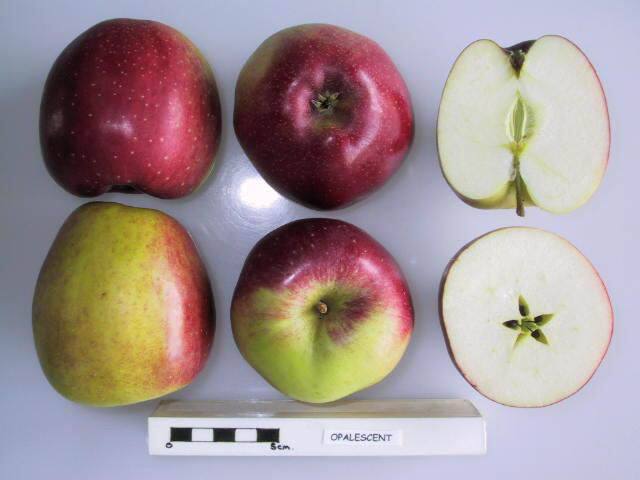Pomiferous
Welcome to the world's most extensive apples (pommes) database.
Information on over 7,000 apples is available here, all carefully researched and provided in a way that is easy to navigate.
Opalescent

type: Culinary, Eating
synonyms: Hastings (This is also the name of a British cider apple, see Hastings )
identification: Large to very large. Round tending to conic. Base colour is pale yellow washed over most of the surface with deep red and lighter streaks. The skin is smooth and covered with an abundance of tan lenticels. The calyx is medium size and partly open to open, set in a deep and narrow basin, surrounded by an even crown. The stem is short to medium, slender and set in a deep and narrow, lightly russetted cavity. Very greasy at maturity and in storage.
characteristics: The flesh is pale cream in colour. Very dense and crunchy. Mildly tart yet sweet. Look for hints of strawberry, pineapple, honey and floral notes.
uses: Traditionally used for baking, but also favoured by some as a fresh-eating apple, albeit large.
origins: When George M. Hudson found a cluster of apple seedlings growing next to an old oak stump in his orchard in Barry County, Michigan (U.S.A.) in the 1870s, he dug up the strongest one and replanted it among his other apple trees. He originally called it Hudson's Pride of Michigan, but the name was subsequently revised to Hastings at his request in honour of the township where the seedling was found. When Dayton Star Nurseries in Dayton, Ohio began to propagate and market it in 1880, the name was once more changed to Opalescent. There is no record of its parentage.
cultivation: Moderately vigorous, upright spreading spur bearer. Produces heavy crops and branches tend to droop by the time the tree is 10 years old. Tolerates Hardiness Zones 4 to 8.
progeny: Shenandoah
cold storage: Keeps two months.
vulnerabilities: Very susceptible to canker, powdery mildew and fire blight.
harvest: In the middle of the fourth period. Fruit holds well to harvest.
pollination group: D
pollination peak: 14
ploidism: Diploid. Self sterile.
cold storage weeks: 8
harvest period: 4
hardiness: 4
Donate a cider?
©2016-2021 Pomiferous.com. All rights reserved